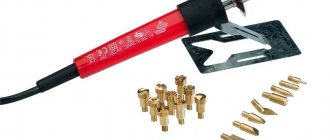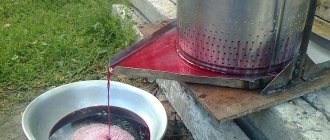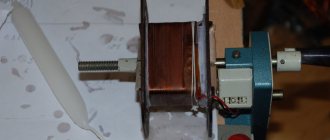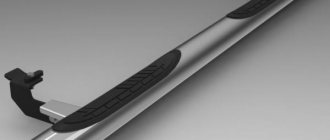The cost of shaped metal parts can be higher than the basic structure, so it is more economical to independently produce corners, ebbs, and other similar products, of the required size for a specific task.
The blanks are bent:
- radially,
- at a certain angle,
- on curved styles.
But the production of products from aluminum, tin, brass, and steel alloys is impossible without special devices. And to do this, you can make a simple sheet bending machine with your own hands in your free time, using a minimum number of tools.
IB2222 Procedure for operating the machine when bending a cylindrical shell
- The sheet is inserted between the top and side rollers. In this case, the edge of the sheet should be aligned parallel to the generatrix of the front roll
- The rear side roller moves to its lowest position
- The front side roller moves to the uppermost position and the sheet is clamped
- The rear side roll moves upward and the leading edge of the sheet is hemmed
- Side rolls are installed in a symmetrical pattern (at the same level relative to the top)
- The sheet moves to the extreme forward position
- The second edge of the sheet is hemmed, similar to the first
- Side rolls are installed in a symmetrical pattern
- The sheet is bent into a cylinder. The bending radius depends on the position of the side rolls relative to the top, which are controlled using indicators located on the right column of the machine
- The left support of the upper roll is folded back and the shell is removed
Attention
Because When bending the edges of the sheet is carried out according to an asymmetrical pattern, in this case greater radial forces arise than with a symmetrical pattern. For this reason, the machine can bend edges of smaller thickness (see Table 1).
When working, more attention is required to the correct adjustment and installation of the workpiece in the rolls, as well as monitoring the movement of the workpiece during the bending process. After each transition, you should check the parallelism of the edge of the sheet forming the roll
The flat workpiece must be pre-corrected because the presence of curvature causes its distortion and displacement of the end edges of the shell.
The displacement of the edges is corrected by reverse skewing of the shell in the rolls. Editing is possible if the shell is not completely bent.
Recommendations for choosing a bending machine
Many people are interested in how a sheet bending machine is selected and what parameters should be paid attention to when purchasing. Professionals advise to consider:
- rigidity, other characteristics of the material to be processed,
- maximum length, thickness of processed workpieces,
- sheet bending clamp diagram,
- equipment weight,
- drive type,
- possibility of bending at a maximum angle,
- availability of adjustments for installing and checking the accuracy of the sheet bender.
Manufacturers add additional devices to the equipment that increase productivity, safety, and work comfort.
Equipment used
The equipment used for rolling is distinguished not only by its versatility, but also by its simplicity of design, so it is not difficult to make it yourself. Of course, homemade rolling machines are optimal for home use, and to equip a production workshop, where the load on such equipment is quite large, it is best to purchase serial models of rollers, which are presented in a wide variety on the modern market.
Both serial and home-made models of machines with which rolling is carried out work on the principle of rolling sheet material around the main roll located on top. Side rollers also take part in this process, which can be moved, thereby adjusting the diameter of the formed shell.
The rollers of this machine are rotated manually, and the approach of the upper roller is done using two handles
Important characteristics of rollers are the radius of their working elements - the rollers, as well as the greatest thickness and width of the workpiece. The radius of the rolls, in particular, influences such a parameter as the minimum bending radius of the workpiece. The larger the diameter of the rolls, the correspondingly greater the value of the minimum bending radius of the sheet metal workpiece. The value of the minimum bending radius is also influenced by the thickness of the sheet itself. As a rule, for rollers, the minimum bending radius of a sheet stock should be 5-10 times its thickness.
Taking into account the high loads that rolls experience during operation, only high-strength steel is used for their manufacture, which can significantly improve their performance characteristics. Based on the number of working elements, two-, three- and four-roll machines are distinguished, with the last two types being the most popular.
Main differences between 3 and 4 roll machines
3-roll sheet bending rollers, the working elements of which can be arranged symmetrically and asymmetrically, although they have a reasonable price, have the following disadvantages:
- low rolling speed (no more than 5 m/min);
- the difficulty of processing workpieces less than 6 mm thick, which can simply slip between the rolls;
- lack of exact coordinates at the clamping point of the workpiece.
The rollers on which an additional fourth shaft is installed are free from all such shortcomings. Due to reliable clamping, the metal sheet blank does not slip between the rollers during processing. This ensures a high rolling speed of 6 m/min or more.
The machine with 4 rolls is capable of producing, in addition to cylindrical, oval and polycentric workpieces
Rollers of this type are usually equipped with automated control systems, which has a positive effect not only on their productivity, but also on the accuracy of the processing performed. The big and, perhaps, the only disadvantage of such a device is its high cost.
What is a zig machine and how to make one
Benching is often used for processing metal sheets. This technology allows you to add strength to products by making ridges on the surface - semicircular depressions.
In addition, on such machines it is possible to apply corrugation to metal, cut or bead blanks. You can make a reliable creasing sheet bender with your own hands, and with an electric drive.
The design consists of two shafts with a horizontal, vertical or inclined arrangement. Forming roller elements are put on them. The workpiece is clamped between the shafts and rotates in different directions. Due to plastic deformation, depressions of the desired configuration and size are formed on the surface of the workpieces.
The design of a manual bending machine with your own hands consists of:
- housings,
- bracket,
- cylindrical shank,
- lock bolt,
- screw with folding handle,
- two shafts,
- spring device,
- casing,
- gear transmission,
- rollers.
Step by step assembly:
- determine the type of drive,
- calculate the main parameters,
- draw up a drawing of a homemade sheet bender,
- prepare the main elements,
- put all the parts together.
Do-it-yourself manual sheet bender for thick sheets
To make such a model of equipment, it is better to take angles and channels, be sure to remove all rust. You can’t do without a welding machine.
The standard design consists of:
- grounds,
- pressing,
- crimping punch.
It is better to use a channel No. 6.5 or No. 8 for the base, a channel No. 5 for clamping, and a corner No. 5 for the punch. The thicker the walls, the better.
The dimensions of the punch and clamp are made 55 mm shorter than the base. According to the description and drawings, it is easy to make such a sheet bending machine with your own hands:
- In the clamping part, drill holes for the bolts strictly along the axis at a distance of 30 cm from the ends.
- Bend the reinforcement with a diameter of 15 mm in the form of a lever and weld it to the corners.
- At the ends of the punch and base, chamfer 7*45° along the edges.
- Add 5 mm thick sheet steel cheeks to the base.
- Drill holes with a diameter of 8.5 mm in the base and cut threads for screwing in clamping bolts.
- Install wings or wrenches on the bolt heads.
How to make a manual sheet bender with your own hands - drawings with step-by-step descriptions and video of work
No matter the skill and experience, it is almost impossible to bend a part of a sheet with a mallet and a mandrel without deforming it. On the Internet you can find many instructions, drawings, photos of homemade sheet benders of various options.
For the traverse device it is enough:
- 4 meters of steel angle with a 50 mm side,
- ball joint for a vehicle equipped with a mounting bracket,
- stabilizer rods with a diameter of 10 mm,
- Bulgarians,
- drills,
- apparatus for electric welding.
The procedure for making a sheet bending machine with your own hands according to the drawings
- Use a grinder to cut pieces of steel angle, each 1 m long.
- Cut two loops from the bracket for the movable crossbar.
- Make an axis from the stabilizer link on which the hinges will rest.
- Measure and mark the axle mounting locations on the corner.
- Accurately align the markings and the top of the traverse in the center of the axis. If the alignment is incorrect, the quality of the bend will be worse, or a do-it-yourself sheet bender will be unsuitable for working with metal products.
- Place the corner pieces next to each other.
- Make markings on the other corner exactly opposite the axis of the first.
- Fold the traverses and secure them for welding.
- Weld the hinges to the second corner.
- Use a grinder to cut a notch around the axis of the clamping angle.
- Drill holes for 10 mm bolts opposite the axles.
- Weld the bolts with the threads facing upwards to the fixed traverse.
- Make a hole in the center of the lower crossmember, but do not weld the bolt, because it will be a removable element. Weld a short axle to it.
- Cut two handles 30 cm long from a 15-20 mm rod and weld them to the bottom of the turning crossbeam.
- Make a frame by welding the fourth corner on both sides to the fixed crossbeam below.
- Drill holes in the frame for fastening to a table or workbench.
Such a powerful, self-made sheet bender allows you to work with workpieces up to 1 m wide and 2 mm thick. Bend angles can be chosen to any size. The edges of the workpiece can be bent stepwise or in any direction, with different bending angles.
Is it easier to buy or make it yourself?
The answer depends on the purpose of use. Even small-scale production will require more physical effort and time when bending with your hands. The accuracy of the parameters is also impossible to achieve. Even a homemade sheet bender will improve your work efficiency.
But the cost of factory equipment is high, and power consumption is high. For one-time use and the production of small parts, the costs will not be recouped. Plus, the machines are mainly designed for bending sheets up to 3 m wide; the hydraulics are complex. The manual drive option is more rational. You can make this type of sheet bending machine yourself. It will improve work efficiency.
Temporary structure according to a simplified scheme
If you need urgent work with tin, the simplest design of a manual sheet bender is suitable, the drawing of which is widely presented online. It is enough to use steel corners and clamps. When processing workpieces:
- the edge of the sheet is clamped between two corners using a powerful clamp,
- bending the workpiece is done by hand.
Typically, simple roofing elements are created in this way. The main thing is to wear protective gloves.
If possible, it is necessary to warm up the metal surface at the bend points. This greatly facilitates bending and reduces the risk of cracking and deformation.
How to make a homemade manual sheet bender
For those who are interested in how to make a sheet bending machine, a simple but effective version of homemade equipment will be useful.
To make it, it is enough:
- three sections of brand 2.5 m long, 70 mm thick,
- two bolts with a diameter of 20 mm,
- a small piece of metal 5 mm thick for the jib,
- springs,
- welding machine.
Step-by-step description with drawings
- Fold two sections of the brand and cut out notches at the ends for the hinges.
- Bevel the edges of the recesses at an angle of 45°.
- Cut the third piece of rolled metal, making the recesses deeper. It will serve as a bar for pressing sheets of workpieces, so it should move freely.
- Weld the hinges on the outer and inner sides.
- Weld jibs to each side of the far tee to install clamping bolts for the clamping bar.
- Weld the bolt nuts to the jibs.
- Install the clamping bar and weld plates at the top with holes in the center, the diameter of which should be slightly the diameter of the bolts.
- Align the holes to the same level as the welded nuts.
- Cut off the spring, calculating the rise of the pressure bar by 5-7 mm.
- Thread the bolt into the “ear” of the press brake, as provided in the diagram.
- After installing the spring, secure the nut.
- Install the second part of the spring on the other side in the same way.
- Weld pieces of reinforcement to the bolt heads, which will serve as handles when tightening.
On such a manual sheet metal bender, the power of which can be easily calculated from the drawing, you can bend even long and thick workpieces.
Types of sheet benders
For various works with metal sheets, different types of sheet bending machines are used:
- with a rotating beam;
- roller;
- roller;
- mechanical and hydraulic presses.
They differ in their technical capabilities and scope of application. All varieties can be made both in mobile or manual, and in stationary versions.
- Pipe benders with a rotating beam are the most common and convenient for DIY production. They can work with large sheets, bending both edges a few centimeters high and a wall of 30–70 cm at an angle of up to 120 0. It is also easy to bend to create a seam connection.
- A manual roller bender is used for bending edges and low walls during body repairs, roofing work, installing window sills and joining large sheets of tin. By choosing a roller profile, you can make a rather complex profiled bend, forming, for example, a fender or a fragment of a car bumper or a decorative element for finishing a fence or balcony railing.
- A roller pipe bender is used for bending semicircular gutters or full-section pipes. It can be adjusted in radius by moving the rolls: the support rolls horizontally, and the pressure rollers vertically. Such a homemade roller bender can be easily equipped with an electric drive with a chain or gear drive.
- Presses will be needed for bending both thin, up to 1 mm, and thick, up to 2–3 mm metal. They are capable of not only bending metal at an angle of up to 90 0, but also perforating it or gluing it under pressure. To change the type of operation, you only need to change the punch and die.
How they work is shown in the figure:
All types of machines are not complicated; it is only important to decide on the upcoming tasks and choose an installation model that will help solve maximum metalworking problems. For example, when making boxes or roofing work, a roller machine will be of little help, but when installing drainage systems, it will become indispensable, while a rotary machine can only partially help
Application area
A purchased sheet bending machine or one made according to drawings with your own hands allows you to produce building parts, metal products, household appliances, or solve household problems.
To obtain the required result, the following operations are used:
- free bending,
- bending with calibrating impact or stretching,
- roller bending, often combined with sheet profiling and cutting.
A homemade sheet bending machine or one offered by different manufacturers is widely used for the manufacture and repair of:
- roofing elements,
- ventilation shafts,
- air ducts,
- frames of windows and doors,
- cornices,
- corrugated sheets,
- furniture boxes, cylinders, fittings,
- car bodies, fenders, running boards,
- housings of washing machines, microwave ovens, refrigerators,
- aircraft industry.
The most popular sheet bending design and its improvement
The design of a manual sheet bending machine, shown in drawing No. 1, can be easily improved. From the above drawing it can be seen that the device for bending sheet metal consists of the following elements:
Drawing No. 1: To build our sheet bending machine we will use this diagram
- pillow made of wood;
- support beam made of channel 100–120 mm;
- cheek, for the manufacture of which a sheet 6–8 mm thick is used;
- sheet of material to be processed;
- a pressure beam made of 60–80 mm corners connected by welding;
- an axis for rotating the traverse (made from a metal rod with a diameter of 10 mm);
- the traverse itself is a corner with dimensions of 80–100 mm;
- the handle of the device is made of a rod with a diameter of 10 mm.
The sheet bending traverse (item 7), which according to the original drawing is supposed to be made from a corner, is conventionally shown as a version made from a channel. Such modernization will significantly increase the endurance of the traverse, which, when using a corner, at a certain moment will inevitably bend in the middle and will no longer create a high-quality bend in the sheet in this place. Replacing with a channel will allow you to do not 200 bends without straightening or replacing this element (which is quite a bit for more or less active work), but more than 1300.
Drawing No. 2: Main elements of a sheet bending machine
Drawing No. 2 allows you to understand in more detail the design of a homemade sheet bender:
- a homemade clamp made from a suitable angle (40-60 millimeters) and a screw with a heel and a knob;
- cheek;
- channel acting as a support beam for the machine;
- a clamping beam bracket made from a 110 mm angle;
- the pressing beam of the sheet bender itself;
- axis of rotation of the traverse;
- the traverse itself.
Strengthening the pressure beam
Below we will look at the clamping bar reinforcement scheme. However, if you initially have a fairly massive corner as a clamp, and you do not plan to bend excessively thick sheets on your sheet bending machine, then it is quite possible to do without reinforcing the clamping bar in the described way.
Whether it is worth getting involved with increasing the clamping pressure depends on the operating conditions of the machine
To extend the service life of the pressure beam and make it comparable to the service life of the traverse, this structural element, which was originally made from an angle according to the drawing, should be supplemented with a base made of a metal strip with dimensions of 16x80 mm. The front edge of this base should be given an angle of 45 degrees in order to align its plane with the plane of the clamping angle itself, and the working edge of this element should be chamfered about 2 millimeters.
In drawing No. 2, the resulting part is shown in section in the additional figure at the top right. These measures will allow the clamp metal to work not in bending (which is extremely undesirable), but in compression, thereby greatly increasing the service life without repair.
You should also take care of milling the lower plane of the pressure beam, which forms the bend. The unevenness of this plane, according to generally accepted rules, should not exceed half the thickness of the workpiece being bent. Otherwise, it will not be possible to bend the workpiece evenly, without a swollen fold line. It should be borne in mind that a beam should be submitted for milling only when it already has all the welds, since their implementation leads to a change in the geometric parameters of the structure.
We increase the reliability of machine mounts
There is another big drawback in the sheet bending machine - the way it is attached to the work table. The clamps provided in this device are a very unreliable fastening option, especially considering the rapid fatigue of welds. Such fasteners can be completely abandoned, which will also avoid the need to use welded joints and jaws. The following actions can solve this problem:
- making a support beam that will protrude beyond the desktop;
- making U-shaped eyes at the ends of the support beam;
- fastening the support beam to the work table using bolts (M10) and shaped nuts with claws.
If the improved sheet bending machine no longer has jaws, how can a crossbeam be attached to it? This issue can be solved quite simply: use butterfly door hinges, which are usually used for hanging heavy metal doors. Such hinges, which ensure fairly high accuracy, can be secured using countersunk screws. This is further illustrated in drawing No. 2 at the bottom right.
You can bend a lot of workpieces on a sheet bending machine with a traverse attached to butterfly hinges, since these hinges are very reliable.
Sheet bending machine for thick sheets
The best option is an electrically driven roller machine or a hydraulic press, since it is difficult to bend significant volumes manually and the impact must be quick and massive.
What is the device
This is stationary equipment with the following features:
- made of metal or hard wood;
- dimensions exceed the workpiece;
- there are moving and fixed parts (shafts, dies, punch and matrix).
The rest of the appearance depends on the specific model.
Application area
The devices are used in factories, auto repair shops, and also in households. Installed outdoors and indoors.
Precautions during operation
- Be sure to wear gloves made of thick materials.
- Protect your eyes with goggles or a mask.
- Regularly lubricate rubbing parts.
- The presence of foreign objects in the working area or on rotating parts is excluded.
- Before starting the operation, check the serviceability of the equipment.
- Do not talk while processing the workpiece.
- Do not rely on a factory or homemade sheet metal bender.
- Carry out the settings after turning off the equipment.
To understand the process, consider the types of sheet bending machines:
Roller
The second name is three-roll. The machine is used to create smooth bent surfaces - large-diameter pipes, semicircular drains and other structures without sharp corners. It works on the principle of a rolling machine. The sheet is profiled between two support rollers and one thrust roller, the movement of which sets the bending radius of the workpiece.
Press brake
The workpiece is placed between two punches (templates), under great pressure they close, giving the required shape to the sheet of metal. Typically used for working with thick workpieces. Useless for household use.
Traverse mechanism
The principle of operation of the design is that the workpiece is clamped with a clamping ruler, and a movable traverse bends the edge to the desired angle. Perhaps the most popular type of sheet bending machine.
There are both industrial stationary machines and manual tabletop devices. In fact, it has no restrictions on the bend angle - from 0 to 180 degrees. The width of the processed sheet is determined by the length of the traverse.
This is the only design flaw. It will be problematic to bend a single rolled strip several meters long at home. But you can quickly make a composite structure of any length with bends for merging the ends.
Popular: What is a matrix and a punch, what is the main difference?
With traverse structures, a bending knife is often used, which is included in the delivery package.
Roller-type end knives are designed for high-quality alignment of the edge of the workpiece.
Roller bending machine
It would be more correct to call it a manual end bender. Although, using a roller mechanism, you can bend workpieces far from the edge. The process is simply too inconvenient. Mainly used as an auxiliary device.
Listogib: is it difficult to do it yourself?
Most craftsmen claim that preparation and implementation generally takes less than a day, despite the fact that the materials need to be processed, because elements that are often rusty and not quite suitable for the parameters are taken. Next, we present the varieties depending on the ease of assembly.
Types for home use
- Rotary (clamping, with traverses) - quite simple, but take up significant space. They can be prepared from scrap materials. They are most effective when combined with cutting knives.
- Rotary (with rollers) - they are much more complicated, since the elements themselves require preliminary metal processing on turning equipment, and an electric drive is an additional complexity.
Advantages of a homemade sheet bender
It’s hard to believe, but a homemade sheet bending machine, made strictly according to the drawings, can be more convenient than a factory one, because:
- Manufacturers' units are designed for a workpiece width of 3 m,
- the price of finished equipment “bites”,
- for delicate work it is inconvenient to use a mechanical drive,
- Energy costs are not justified if the parts are small or require one-time use.
With the help of a manual drive, physical forces can be easily adjusted in homemade sheet benders. They are easy to operate and can bend workpieces just as well as mechanical or hydraulic ones. These metal sheet benders are easy to repair.
Drawings for creating sheet metal bending machines
Tool with rotary frame for bending workpieces
Home craftsmen most often use a similar DIY device for bending sheet products. Moreover, it differs from other sheet bending machines in its great versatility. The desktop in it is made of metal or wood. The dimensions of such a sheet bending machine are no less than 2x1 m. If you need to bend large workpieces, you can install a plane on the back of the device, located at the level with the table, or a folding frame. This is done to secure the metal so that it does not slip out when changing position.
The base should be screwed to the front of the desktop. To do this, you will need a channel with a width of the upper edge of no more than 7 cm. Guide pins with springs are mounted at its ends. A clamp is then fixed on them, the front edge of which should be beveled at an angle of 45 degrees.
To create the rotating part, use a corner measuring 5x5 cm with an installed handle. It is mounted on hinges in such a way that the upper edge of the material, when folded back, is located at the same level as the base.
The simplicity of the design of such a sheet bender and the availability of materials for its assembly allows you to save a lot. In many cases, metal for the work table and frame does not even need to be purchased, because every workshop has cuttings of pipes, angles and channels. These leftovers will make an excellent homemade machine for bending metal sheets.
Drawing of a device from brands
To make such a sheet bending machine, you will need the following materials:
Smooth surface, preferably metal; At least 3 corners with a shelf width of about 45 mm and a thickness of approximately 3 mm.
A homemade sheet bending machine is made from a brand. You will need three pieces of such a product, 2.5 meters each, a small metal plate 5 mm thick for the jibs, two bolts 20 mm in size, and also a spring. First you need to fold two brands, and then make holes for hinges at both ends. In this case, the edges of the pits are beveled at an angle of 45 degrees. The remaining product is cut in a similar way, only the notch is made deeper to be used as a pressure strip.
Then you can proceed to welding the hinges. This must be done from the outside and inside. Then the jibs are fixed to one brand. After this, a pressure plate is mounted, and metal plates with a recess in the center are welded to it on top. The diameter of such a hole should be slightly wider than the bolt. The hole should be aligned so that it is located on the same plane with the installed nut and welded.
The next step is to cut off the spring; it should raise the pressure bar by as much as 7 mm. The bolt must be inserted into the hole of this product, install the spring and screw the nut. When the same elastic part is mounted on the other side, when unscrewed, the bar will rise on its own.
To make a device for tightening, you need to attach pieces of reinforcement to the head of the screw. After this, all that remains is to weld the handle to the movable brand and you can start working. Such a machine will be quite powerful; it will be able to bend even thick and long sheets.
DIY roller bending machine
When creating and installing chimneys, ventilation ducts and drainage systems, one cannot do without curvilinear bending of a metal sheet. Roller benders do an excellent job with this task.
It’s quite easy to build equipment with your own hands with three rollers. In addition, it can be equipped with an electric motor or a manual drive. The main parts of the roll bending machine are as follows:
Vertical supports made of channel material on bearings and with recesses for axles. Longitudinal shafts. You need 3 of them; pipes of different diameters with welded ends are suitable. It is better to use thick products like this to prevent deformation. Frame. Upper roll pressure unit. Chain or gear drive. It is necessary to ensure that the rolls rotate at the same speed and in the same direction. Clamps. They move the support rollers horizontally.
One vertical stand in the machine should rotate around its axis by 90–120 degrees. This must be done in order to subsequently replace the rollers with cylinders of a different size. During the manufacture of a roller-type device, it is worth understanding that its capabilities will be limited by human power. Using such homemade equipment, sheet metal up to 60 cm wide and no more than 1.5 mm thick can be bent. The diameter of the trough can be adjusted by moving the rollers.
Rating of the best models
There are many similarities between existing equipment models. When choosing machines, industries involved in metal processing are guided by ratings, which are compiled based on reviews of people working on them and the opinions of experts.
Shrinker STALEX SS-18
Mechanical machine from a domestic manufacturer. The average price is 10,600 rubles. Refers to professional equipment. Designed for the production of S-shaped products from sheet metal. Bending of the material can be carried out along the inner and outer diameter of the sheet. The maximum thickness of the processed material is 1.2 mm.
Advantages:
- Mobility.
- Reliability.
- Anti-corrosion protection of the housing.
- Easy to use.
- Ability to work with internal and external diameters of the material.
Disadvantage : you cannot work with thick metal sheets.
Nikita R. review:
The sheet bender has a convenient adjustment of the speed of movement of the cutting blade. I am impressed by the ease of operation and reliability.
LSP2000
A manual machine widely used for the production of corrugated fences with a maximum wave height of 15 mm. The average cost of LSP2000 is 132 thousand rubles. Machine weight 225 kg.
Advantages:
- High performance.
- When bending sheets, the surface layer of paint is not damaged.
- Ease of operation and maintainability.
- Good value for money.
Disadvantage : heavy weight.
Maxim Sh. review:
The machine is constantly in operation. No complaints. Reliable, easy to use. I like the cutting quality of the knife.
Stalex ETB-25
Professional electromechanical beading machine. The average cost is 199 thousand rubles. Machine weight 235 kg. The maximum thickness of the processed material is 2.5 mm. The main area of work is plastic processing of thin sheet metal.
Advantages:
- Reliable all-metal construction.
- Easy to use.
Flaws:
- High price.
- Heavy weight.
Alexey N. review:
I used a machine for bending round and rectangular pipes. He gets the job done quickly and efficiently. No physical effort.
PSBM-1270-2.5M
Three-roll mechanical sheet bending machine. The Czech brand is produced in China. The average cost is 275 thousand rubles. Machine weight 450 kg. It can bend stainless steel up to 1.5 mm thick. The frame of the sheet bender is made of cast iron. The shafts are surface hardened. The machine is used for the production of chimneys and ventilation. It can be used to bend metal rods and pipes and make funnels and buckets.
Advantages:
- The equipment does not require connection to an electrical network.
- Reinforced body.
- Easy to maintain.
Flaws:
- Large mass.
- High price.
Anton R. review:
The machine is easy to maintain. Works without breakdowns.
Stalex 2500/2.0
Manual sheet bender equipped with a convenient clamping system. The average cost is 520 thousand rubles. Machine weight 800 kg. The equipment is widely used for the production of additional rigid roofing elements, ventilation elements and profiles. The machine is equipped with high precision goniometers. The clamping mechanism has a tip that prevents your hand from slipping during operation.
Advantages:
- Material bending angle up to 150 degrees.
- High performance
- Ease of maintenance
- Safety.
Flaws:
- High price.
- Large mass.
Evgeniy G. review:
Machine with unlimited material feeding depth. High performance. Convenient to use. Has a wide range of capabilities.
MVN-3020
Professional, high-performance hydraulic press. The average cost is 1050 thousand rubles. The weight of the machine is 1.5 tons. The sheet bending machine is distinguished by high precision work. The equipment includes several dies that allow you to make bends of any shape. The machine can be used for the production of piece and serial products.
Advantages:
- Multifunctionality.
- High performance.
- Precision in work
- Safety.
- Easy to maintain.
Flaws:
- Large mass.
- High price.
Sergey Yu. review:
The machine has proven itself well under intensive use. Almost unbreakable. The fold lines are perfect.
Stalex SBHF-1
Tunnel assembly sheet bending machine. The average cost is 1800 thousand rubles. Weight 700 kg. Widely used for straight sections of straight section ventilation ducts. At Stalex enterprises, SBHF-1 is included in automatic lines. Provides high productivity in mass production.
Advantages:
- Smooth fold edge.
- High quality build.
- Durability.
- Easy movement of the bending bed.
- Easy to maintain.
Flaws:
- Large mass.
- High price
Dmitry Ch. review:
A very successful sheet bending model. I use it to produce window profiles. The machine can be operated by one person.
Types of sheet benders and their design
Before you start making a homemade manual sheet bender, you should clearly define the list of tasks for which it is needed. The main purpose of such a device will depend on what scheme it will be implemented according to.
The simplest is a device in which sheet metal is bent using a special traverse. Using such a device, you can easily bend a sheet of metal at an angle of 90 degrees, using only hand strength without additional devices, if the width of the sheet does not exceed 0.5 meters. The base of the sheet is secured with clamps or in a vice, and its bending is carried out due to the pressure exerted by the traverse. In some cases, to obtain a bend angle of exactly 90 degrees, you may need an embedded spacer (in the picture on the right), which is an ordinary strip of metal that will help compensate for the elasticity of the sheet.
The most common scheme for a homemade sheet bender
A more complex design is the press brake, which consists of a die and a punch. The sheet metal in such a device is located on a matrix, and the punch is lowered onto the workpiece from above, giving it the required profile. At home, a press brake is unlikely to be used, since it is quite complicated and unsafe to use.
Diagram of operation of a press brake
A version of a homemade sheet metal press, working in tandem with a self-made hydraulic press. If you already have a press, then supplementing it with devices for bending narrow sheets of metal will not be difficult. You'll get something like this:
Homemade press brake option
A sheet bending machine is much more advanced, in which metal is bent by the action of three shafts. Such equipment is called pass-through. One of its main advantages is that its adjustable rollers allow different bending radii. Such a tool for bending metal can be manually or electrically driven, and its rollers can have a different design.
Most factory sheet benders from the lowest price segment are made according to this scheme.
- Rollers with a smooth working surface are designed to perform most sheet metal work, which involves bending workpieces, producing sections of pipes with large diameters, etc.
- Profiled rollers are necessary for bending elements of roofing structures (ridges, valleys, gutters, flanges, etc.).
- The broaching sheet bending machine can be additionally equipped with a support, a clamp and a traverse, which allows it to be used for manual bending of workpieces.
Such machines are equipped with a set of shafts of various profiles, which can also be purchased additionally to make the equipment more versatile.
Where to start making a sheet bending machine
To make a machine for bending sheet metal, you will need a drawing of such a device or its detailed photos. In addition, a number of important factors should be taken into account, such as the force that will need to be applied to use the sheet bending machine, its weight and dimensions (on which mobility depends), cost and availability of components. As a result, we obtain the following initial parameters.
- The maximum width of the sheet that will need to be bent is 1 m.
- Maximum thickness of sheet material: galvanized – 0.6 mm, aluminum – 0.7 mm, copper – 1 mm.
- The number of operating cycles that will be carried out without readjustment or repair is 1200.
- The maximum bend angle of a metal profile, obtained without manual finishing, is 120 degrees.
- It is highly undesirable to use workpieces made of special steels (for example, stainless steel).
- In the design of a sheet bending machine, welded joints that do not withstand alternating loads should be avoided.
- You should limit as much as possible the number of sheet bending machine parts that you will need to order externally, using turners or millers.
It is very difficult to find a drawing of a device that would satisfy all these requirements, but the most successful one can be modified.
How to increase the strength of machine mounts
Many novice craftsmen make homemade devices without a base. These are sheet benders that are secured to the workbench using clamps. When actively working with such a mechanism, the fastenings will become loose. The technician needs to constantly clamp the fasteners. To get rid of this drawback, you need to make a support beam, assemble a base from channels, and install braces from metal corners.
You need to make a desktop on the base. To do this, you need to attach a sheet of metal with stoppers to the structure, which will limit the depth of fixation of the workpieces.
Design features
Massive machines have a simple design.
The main structural element is a steel beam - a traverse. A metal sheet is placed on it, which is bent at a given angle using a pressing knife. This can be done by turning the traverse or by pressing on the material from above.
To control the bending angle, special limiters are installed on the equipment. In CNC machines, this function is performed by sensors installed at the edges of the working surface. The sheet bending process stops when the required deformation angle of the material is reached. The rounded profile is made on sheet bending machines, which work on the principle of pressing metal sheets into a matrix.
Design of a sheet bending machine and its improvement
The installation of a manual sheet metal bending machine can be easily improved. To build a sheet bending machine, this scheme is used:
- Pillow made of wood;
- The main beam is made of channel 10−130 mm;
- Cheek, for the production of which a sheet 7-9 mm wide is used;
- Manufacture sheet subjected to finishing;
- A pressure beam made of 70-90 mm corners connected by welding;
- Rod for rotating the traverse (made from an iron rod with a diameter of 11 mm);
- The spacer itself is an angle with dimensions of 90-110 mm;
- The handle of the device is made of a rod with a diameter of 12 mm.
The sheet bending traverse, which according to the initial drawing is planned to be made from a corner, conventionally shows an option made from a channel. Such an improvement will several times increase the endurance of the traverse, which, when using a corner, at a certain moment will certainly bend in the center and will not form a high-quality sheet bend in this place.
Replacing with a channel will allow you to do not 250 bends without straightening or replacing the provided element (which is quite a bit for more or less constructive work), but more than 1400.
The design of this home-built sheet metal bending machine can be further improved, making it more efficient and versatile.
The second option allows you to understand in more detail the installation of a homemade sheet bender:
- A homemade clamp made from a suitable angle (50-70 mm) and a screw with a heel and a knob;
- Cheek;
- Beam acting as the reference point of the machine;
- Pressure beam bracket made from 120 mm angle iron;
- The pressing beam of the sheet bender itself;
- Traverse rotation axis;
- The traverse itself;
- Strengthening the pressure beam.
Below is a diagram of increasing the pressure bar. However, if you initially use a rather powerful corner as a clamp, and you don’t plan to bend extremely thick sheets on your sheet bending machine, then you can do without reinforcing the clamping bar using the described method.
In order to extend the service life of the pressure beam and make it comparable to the service life of the traverse, it is necessary to increase the provided structural element, which from the very beginning according to the drawing is made of a corner, with a base made of a metal strip with dimensions of 17x90 mm.
The front edge of the provided base must be given an angle of 45 degrees in order to level its area with the plane of the pressing corner itself, and specifically the working edge of the provided element must be chamfered about 3 millimeters. These measures will allow the clamp metal to act not on bending (which is extremely inappropriate), but on compression, thereby increasing the service time without repair many times:
- A special 61 angle bracket attached to the rear flange of the main clamp angle will keep it from bending upward.
- You should also think about milling the lower plane of the pressure beam, which forms the bend.
- The unevenness of the provided plane, according to generally accepted rules, should not exceed fifty percent of the thickness of the workpiece being bent.
- Otherwise, it will not be possible to bend the blank evenly, without a swollen fold line.
It is necessary to keep in mind that you need to submit a beam for milling only when it already has all the welds, since their execution leads to a change in the geometric characteristics of the structure.











